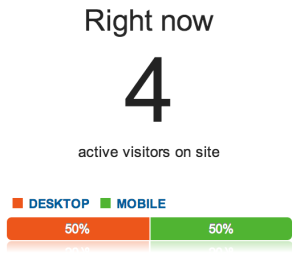Maybe I’m the last one realizing this, but it was actually recently I learnt that a session in Google Analytics that spans over multiple dates, for example 23:55 – 00:05, will be split into two sessions. Good to know if you for example work with conversion funnels.
AMP (Accelerated Mobile Pages)
There’s been a lot of buzz around the AMP Project lately, especially outside the development community. One reason for this is the news that Google will prioritize AMP pages over mobile apps in mobile search results. Site owners, SEO experts, digital marketers and so on are all trying figure out how to approach this. Me included. So I do what I usually do when I want to understand something technical related – I get my “hands dirty”, which in this case means building a web site using the AMP approach.
Web Site
www.spaghetticode.se
There is not much to see at the moment (2016-09-30). So far it’s a basic AMP page, with some basic styling and analytics. Most of it is pretty straight forward, except that external stylesheets are not permitted and adding Google Analytics is a bit different to the usual approach. You can’t for example just copy and paste the tracking code – it requires a different set up.
I won’t go into any more details, instead I’ve added a bunch of useful link if you are interested in learning more.
Blog Stats, August 2014
It’s time for one of these ‘not so interesting for you, but interesting for me posts’.
Looking back at the August numbers was fun, simply because my latest post ‘Experimenting with the element.animate() function‘ was featured in codrops COLLECTIVE #128 which created a traffic spike.
New vs Returning Visitors
New: 91,4%
Returning: 8,6%
Top 5 Countries (based on sessions)
1. United States
2. Germany
3. France
4. Sweden
5. United Kingdom
Top 5 Browsers (all versions)
1. Chrome
2. Firefox
3. Safari
4. Safari (in-app)
5. IE
… 13.62% didn’t have Flash installed/support.
Top 5 blog posts (based on sessions):
1. Experimenting with the element.animate() function
2. How to maintain the end state in a CSS Animation
3. Animated Submit Buttons
4. Web Development Tools and Resources
5. Tracking Across Synced Devices
Blog Stats, June 2014
Here’s some stats from the past month, June.
New vs Returning Visitors
New: 62,90%
Returning: 37,10%
Top 5 Countries (based on sessions)
1. Sweden
2. Brazil
3. USA
4. India
5. Canada
Top 5 Browsers (all versions)
1. Chrome
2. Firefox
3. Safari
4. Safari (in-app)
5. IE
… 46.67% didn’t have Flash installed/support.
Top 5 blog posts (based on sessions):
1. How to maintain the end state in a CSS Animation
2. Animated Submit Buttons
3. Tracking Across Synced Devices
4. Web Development Tools and Resources
5. SO Answers
Tracking Across Synced Devices
A question came to my mind the other day:
How is a visit treated in Google Analytics (GA) when you move across synced devices? As a new visit or is the cookie shared, keeping the session alive?
My first thought was that the cookie wasn’t shared, although I wouldn’t of been surprised if at least users with Chrome’s Tab syncing feature could be tracked. Simply because they need to op-in to their Google Account (and Google owns GA) to be able to use the feature which basically could identify them across devices. But then again, even if this was possible, I wasn’t sure if this metric would be available to GA to distinguish the users. So I wrote the following tweet:
How is a visit treated in GA when you move across synced devices? As a new visit or is the cookie shared, keeping the session alive?
— Christofer Vilander (@c_vilander) March 21, 2014
Nobody seemed to have an answer, so I decided to ask the question on webmasters.stackexchange.com. 10 days later, I’ve only received one answer saying that the visits are most probably treated seperately and if I’m looking for cross-device tracking I should upgrade to Universal Analytics (UA). Even if the answer gave me some valuable insights regarding UA it didn’t answer my question really, so the next step was to test it myself …
I created a new website and implemented GA-tracking. The reason for this was to make sure that no other visitors would access the site during the test. I then enabled iCloud Tabs and Chrome’s Tab feature on my Mac and iPhone. Visiting the website with Chrome and Safari (desktop versions) gave me two active visitors in GA and when I enabled each tab in Chrome and Safari on my iPhone the Real-Time data in GA showed four active visitors, which later also turned out to be four unique visitors.

So according to my small test it seems that GA treats visits across synced devices separately (Visits 4, Unique Visitors 4).
My Blog Statistics for 2013
I’ve spent the evening digging into Google Analytics and I thought I’ll share some stats from the year that’s gone by. But first I would like to thank you all for visiting my blog.
My most popular blog post (based on visits):
Animated Submit Buttons
.. and second most popular blog post was:
How to maintain the end state in a CSS Animation
Looking at some numbers …
New vs Returning Visitors
Returning: 71,81%
New: 28,19%
Channels (visits)
1. (not set): 54.83%
2. Organic Search: 17.18%
3. Direct: 16.22%
4. Social: 10.62%
5. Referral: 1.16%
Top 5 Countries (visits)
1. Sweden
2. United States
3. United Kingdom
4. Italy
5. Germany
Top 5 Browsers (all versions)
1. Chrome
2. Safari
3. Firefox
4. Internet Explorer
5. Android Browser
No surprises here really. But as a side note, I can mention that 48% of my visitors didn’t have Flash installed. Not bad …
And that’s that, a brief summary of my blog stats for 2013. Now I’m looking forward to 2014.